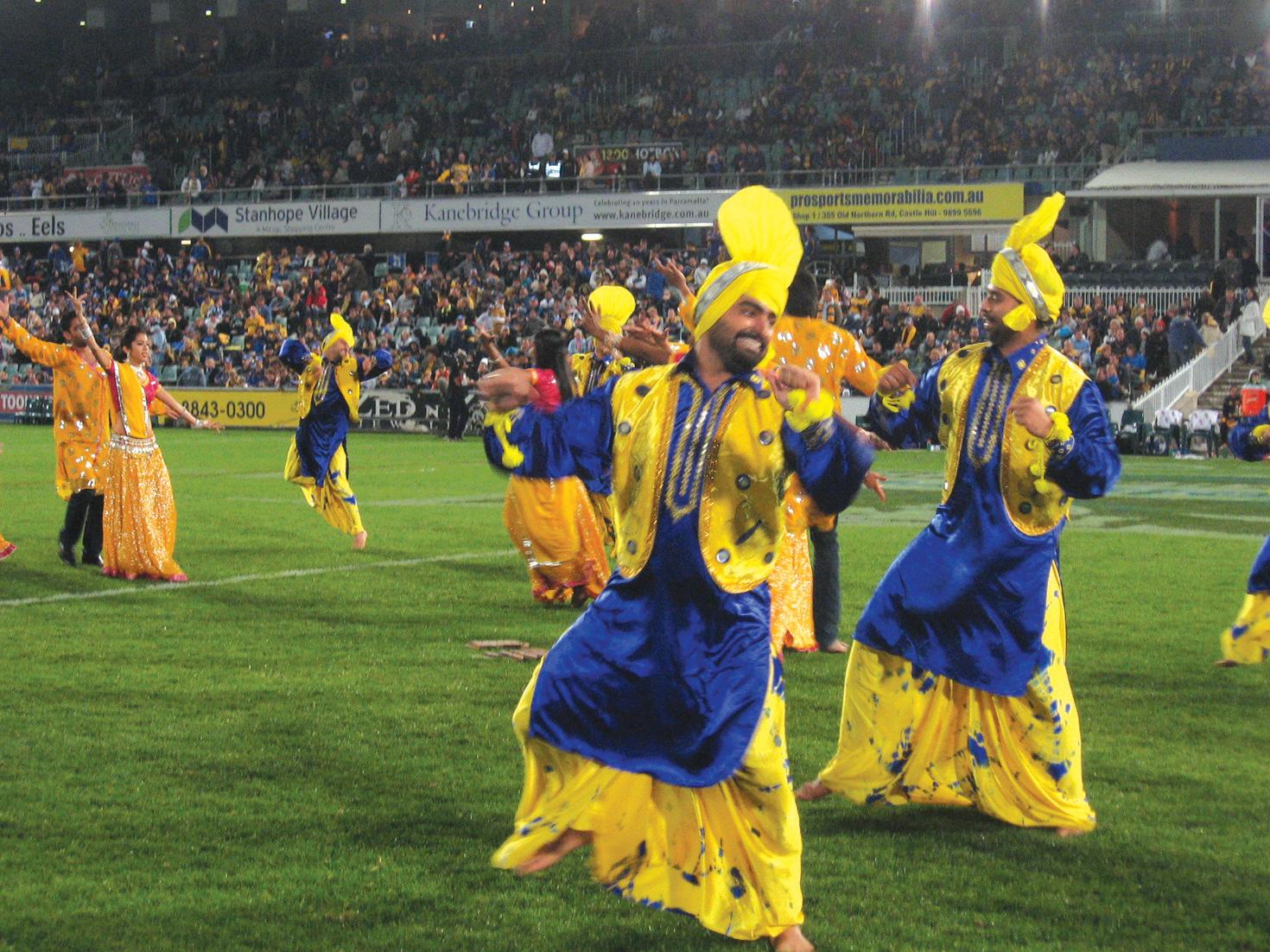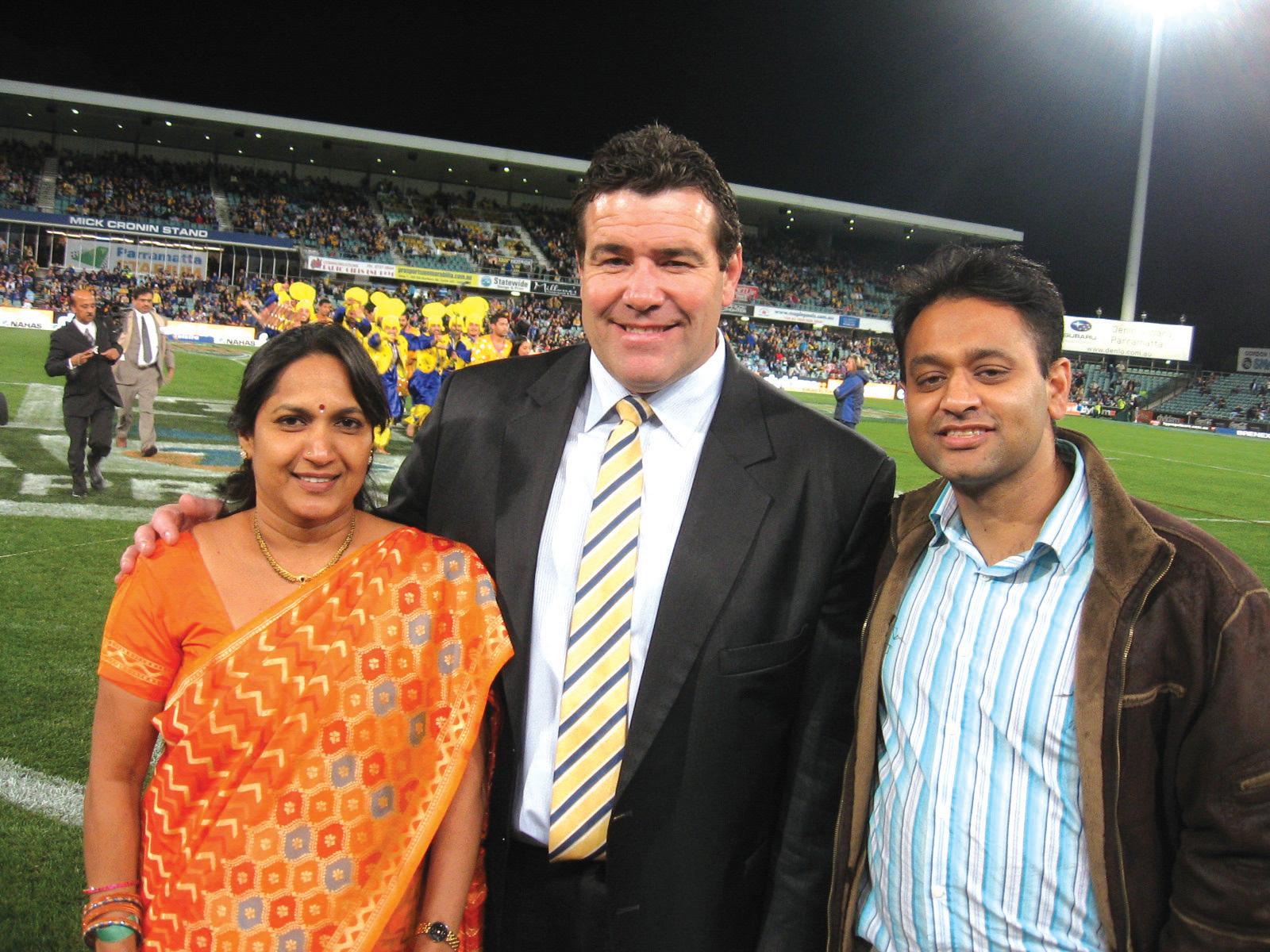
5 minute read
An Indian link at Eels match
from 2010-06 Melbourne
by Indian Link
There was a palpable air of excitement at the Parramatta Stadium, as the home team, the Parramatta Eels took on the Cronulla Sharks in Round 11 of the National Rugby League on May 22. Fans braved the cold and wind to root for their team, and splashes of blue and gold dominated the crowd at the stadium. The air of anticipation was shared by over 200 Indian fans who were invited to attend the game in support of the home team.
The Pirtek Parramatta Eels had earlier visited Billu’s at Harris Park to give away 200 passes to members of the Indian community, inviting them to attend the match and experience the magic of an NRL game. This initiative had a dual objective, that of forging closer links with the Indian community as well as inciting an interest in the game. The Parramatta Eels are a strong team representing a city in which a majority of the residents originate either from India or the sub-continent, and whose presence is now a significant one.
The United India Association (UIA) was instrumental in supporting this initiative, with UIA President Aruna Chandrala attending the event, along with a host of prominent members of the Indian community and its media. They were hosted by Pirtek Parramatta Eels club CEO Paul Osborne and Special Projects Manager Bonnie Scott, in a corporate box. However, the highlight of the evening was a performance of Bollywood’s best in bhangra and beats, by Indian dancers. They performed a medley of dances at half time, much to the surprise and applause of the spectators. For many it was a unique experience, and one never before witnessed within an NRL game at the stadium. The bhangra dancers, fittingly attired in the Eels distinctive colours of blue and gold, rocked the stadium with a lively performance and an enthusiasm that lived up to that of the players on field in the first half. Next followed a couple of dance sequences and the finale, of course, the popular and indomitable Jai Ho!
Ms Chandrala invited the spectators to attend this year’s Australia India Friendship Fair to be held on August 15 at the Sydney Olympic Park, where they could experience a closer interaction with all things Indian. The fair is an annual event and showcases India’s heritage, culture, tradition, diversity and food.
“It was exciting to experience the atmosphere of an NRL game,” said Vivek Trivedi, a first-time spectator of the sport.
“The half time Bollywood performance was very well received and made a positive statement about the Indian community’s support for the Parramatta Eels.”
Earlier this year, Mr Osborne and Mr Scott had visited India in a quest to obtain a better understanding of Indian culture and to establish important relationships. It was a fruitful and enlightening visit, causing the initiative to be introduced and subsequently launched. They hope that their new partnership with UIA will entice the Indian residents of Western Sydney to develop an ongoing interest in the Eels and hopefully, an ongoing relationship with the club, uniting the community through Rugby League.
For UIA, this was yet another first and a successful initiative, as it helped promote assimilation into Australia’s culture through the medium of sport, which is ever-popular in this country. It was also interesting to note that the invitations to the game were enthusiastically accepted within a community which, up until now, has shown an avid interest mainly in cricket, rather than any other true-Aussie sport.
Although the Parramatta Eels lost the match, this significant event heralds the start of a fruitful, mutually beneficial and longstanding relationship between the sport and the Indian community.

One such player lived on my street in a weatherboard house barely a hundred metres away. I would sometimes wait on my front lawn to catch glimpses of him leaving for training in his blue and gold tracksuit. My friends and I once knocked on his door in the hope of obtaining an autograph, only to be disappointed by his absence.
While I have long given up on my hopes of playing half back, Rugby League still occupies an important place in my heart. It is a link to my childhood of lazy afternoons playing sport in backyards and parks, of mingling with my teenage tribe, all from immigrant backgrounds and of bonding with my father watching the games on television or at the stadium. My mother was often confused when she discovered us swearing at referees on the TV set.
Like all true sporting fans, my father and I shared in both the disappointments and euphoria of victories and defeat respectively, almost as if we were the ones kicking the ball or scoring the tries ourselves.
Almost two decades on from the heady period of Parramatta’s glory days, the team and sport have grown to become major corporate entities and key cultural institutions. Any game where Parramatta features on television rates higher than any other team in any football code in Australia. The club is arguably one of the major embodiments of working class Australia, or “working families” as the Prime Minister likes to call them.
Much like cricket in India, the contained period of time and space within which a sporting encounter takes place represents all the ups and downs of life in a short, consumable product outside the working week. The popularity of sport is not just that it is like a mock war, but within its boundaries play out the themes of love and loss, politics, territory won and lost, crushed hopes and dreams and, very occasionally, conquest against the greatest odds.
The innovative gesture from the
Parramatta club, led by its CEO Paul Osborne who spoke to me of his awe and wonder after a recent trip to Bangalore, to attract members of the Indian community to the club is to be commended. While it may have a commercial basis, there is nothing wrong with ventures that can be mutually beneficial. This has been the positive nature of trade since time immemorial.
The fact that a particular geographic area is now being associated with Indians is in fact, very important. I have heard from politicians in the past that ethnic groups do not easily have clout unless they can be linked closely to a particular area and, more importantly, to a particular seat.
Such clustering is not always a positive thing, but the last few years have seen the Indian and South Asian expatriate community come of age within Australia. From broad success and successful integration to stronger bilateral relations between nations, the community is becoming stronger and more prominent. The student crisis was, of course, a blight on such a trend, but it also highlighted the emerging muscle and importance of both India and the local community.
It is also important that Indians are not solely associated with cricket in the sporting arena. Part of modernising is expanding the perception of South Asia in general, away from idealised, orientalist myths. There can be no better symbol of Indian-Australians and their integral role in modern Australia than an association with Rugby League, of all things.
It remains to be seen whether the campaign will actually lead to increased club memberships. The product needs to be attractive. But there is no doubt it has already generated a great deal of goodwill and opened minds about how ethnic communities can better interact with core Australian institutions.










